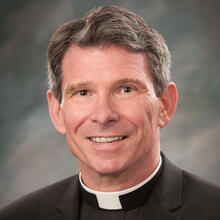In 1945 a young Flannery O’Conner graduated from Georgia State College for Women. She then went off to the University of Iowa, to study journalism. College hadn’t really challenged the Roman Catholic faith, implanted in her by family and the parochial schools of Savannah, Georgia. The University of Iowa did. Like so many students today, O’Connor changed her course of study. She abandoned journalism and enrolled in the prestigious Iowa Writers’ Workshop.
If writing with intellectuals challenged her faith, writing to God was one way she sought to restore it. In January of 1946 she began a prayer journal, one in which she frequently struggled with suffering. I almost wrote, “with the meaning of suffering,” as that’s our modern question, but it wouldn’t be true to say that Flannery struggled with suffering’s meaning. She believed the cross of Christ gave it all the purpose it could possibly have. No, Flannery struggled to accept suffering, which she saw as the path to God.
In one journal entry, she does confront a particularly modern problem, yet one we seldom acknowledge. What does the cross of Christ mean in a world that no longer cares? She wrote:
It is hard to want to suffer; I presume Grace is necessary for the want. I am a mediocre of the spirit but there is hope. I am at least of the Spirit and that means alive. What about these dead people I am living with? What about them? We who live will have to pay for their deaths. Being dead what can they do? It is for them, I presume, that the saints died. No, the saints died for God and God died for the dead. They didn’t have to submit to God’s indignity. No one can do again what Christ did (33).
At this point in her life, the young Flannery O’Connor knew nothing of her Lupus, the disease that will soon dominate her days, forcing her home to live with her mother, curtailing her career as a celebrated author. She simply knew, as she was taught, that our suffering is purposeful when conjoined to Christ’s.
But what about “these dead people,” those who neither believe, nor care, that Christ died for them? When the Medievals mourned the Savior’s death, they did so in union with the world they knew. Does contemporary indifference dilute the very meaning of Christ’s act? How does one meaningfully mourn what the modern world ignores? Fundamentalists, of every faith, declare themselves at war with the world. They cite its blindness—What is truth? (Jn 18:38)—as one more indictment of its sin. But is that an option for a Catholic, who believes that Christ loved the world for which he died?
Good Catholic that she was, Flannery’s first thought was to take responsibility for those who are spiritually dead. What should she be doing to raise them to life? But then came the realization that Christ’s sacrifice, his death, is more than a moral lesson, more than an example of selfless love for others. We can’t do what Christ did. Exert all the human effort we will, we won’t reclaim what was lost in the Fall, the moment humanity squandered its destiny.
“No, the saints died for God and God died for the dead. They didn’t have to submit to God’s indignity. No one can do again what Christ did.” Flannery’s right. We can’t be our own saviors, a phrase I often repeat in the confessional.
In Christ, God goes to the uttermost point of human alienation, enters death itself, so as to carry us back to life. “No one can do again what Christ did.” Show me someone who can carry himself.
Yes, so many in the world are blind, not to know their need for a savior. Sin does that. It darkens our native intelligence. So how do we confess a Savior to “these dead people,” who think they live?
We give ourselves over to history and to hope. We await and attend the plans of God. On Calvary, our age was as clearly in his sight as Caesar’s. What Flannery wrote of an artist’s life is equally true of a believer’s:
It will be life struggle with no consummation. When something is finished, it cannot be possessed. Nothing can be possessed but the struggle. All our lives are consumed in possessing struggle but only when the struggle is cherished and directed to a final consummation outside this life is it of any value (29).
We are asked to have faith, even in a world that falters. All that we own is the struggle for faith. The consummation is God’s.
Isaiah 52:13-53:12 Hebrews 4:14-16, 5:7-9 John 18:1-19:42








